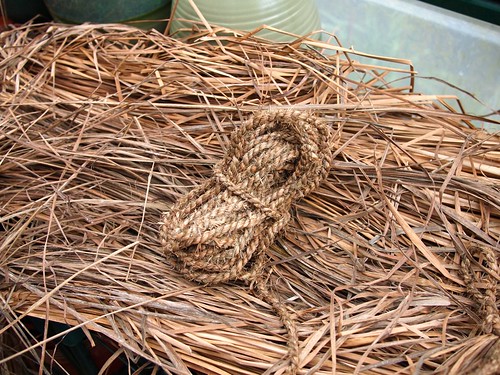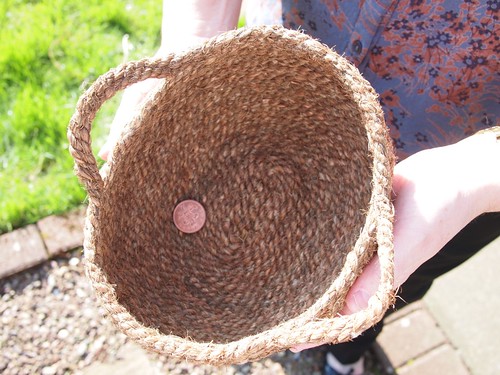Cordage Conundrum
- Thread starter Bishop
- Start date
-
Come along to the amazing Summer Moot (21st July - 2nd August), a festival of bushcrafting and camping in a beautiful woodland PLEASE CLICK HERE for more information.
You are using an out of date browser. It may not display this or other websites correctly.
You should upgrade or use an alternative browser.
You should upgrade or use an alternative browser.
I've absolutely no idea, but I must say the standard of you work looks very good indeed.
I suspect the only real way of knowing is to test a bit of it.
Dave
I suspect the only real way of knowing is to test a bit of it.
Dave
I have a feeling that the rule of thumb is that you lose a third of the breaking strain when you knot a rope. So maybe (4x84)x2/3=224lb
The question you are asking, from an engineering standpoint is a big "it depends".... In an ideal world and assuming that you strands are 84lb each and that you have made a perfect lay without any: pinch points, flat spots, loose sections... Etc. Then your resulting rope can be as much as 84 x 4 = 336.
In reality given that knots can diplay around 40-50% [Dependant on material] reduction in tensile strength, it could be fairly safely assumed that more minor infractions in the structural integrity are likely to see less drastic impact in strength of around 20% [a possible over estimation that strongly depend on material used]
I would say that your resulting rope is anywhere from 168lb [Unlikely, unless there are serious structural issues] to 268lb [Probably a fairly safe estimate].
But this is all conjecture, as ropes can only really be confirmed by a destructive test.
Anyway, it looks brilliant and you have inspired me to have a go myself.
In reality given that knots can diplay around 40-50% [Dependant on material] reduction in tensile strength, it could be fairly safely assumed that more minor infractions in the structural integrity are likely to see less drastic impact in strength of around 20% [a possible over estimation that strongly depend on material used]
I would say that your resulting rope is anywhere from 168lb [Unlikely, unless there are serious structural issues] to 268lb [Probably a fairly safe estimate].
But this is all conjecture, as ropes can only really be confirmed by a destructive test.
Anyway, it looks brilliant and you have inspired me to have a go myself.
The question you are asking, from an engineering standpoint is a big "it depends".... In an ideal world and assuming that you strands are 84lb each and that you have made a perfect lay without any: pinch points, flat spots, loose sections... Etc. Then your resulting rope can be as much as 84 x 4 = 336.
In reality given that knots can diplay around 40-50% [Dependant on material] reduction in tensile strength, it could be fairly safely assumed that more minor infractions in the structural integrity are likely to see less drastic impact in strength of around 20% [a possible over estimation that strongly depend on material used]
I would say that your resulting rope is anywhere from 168lb [Unlikely, unless there are serious structural issues] to 268lb [Probably a fairly safe estimate].
But this is all conjecture, as ropes can only really be confirmed by a destructive test.
Anyway, it looks brilliant and you have inspired me to have a go myself.
That's a good and informative post, thanks for it
This isn't as easy a question as basic arithmetic. There are several things in play here.
Firstly, the original string is garden twine. It's generally of a 'rot-able' nature. It's not intended for any great strength and is often spun from fibres that haven't been stripped of the debris from the retting process.
Basically you're not starting from a product with a known/sound tensile figure.
Secondly, tensile as in holding a weight, that's not something chugging on that weight, nor the effects of rain on the cordage either stretching, shrinking or loosening the twist and plies.
So, the dry tensile weight of an average piece of the cordage.
Measure off a metre of your cordage, slide it through the handles of a nylon shopping bag (I reckon the cordage will take weight that would tear a plastic one) and while keeping hold of both ends, slowly add in weight. Bags of sugar, tin cans, workout weights, etc., Just keep adding them up.
If you knot the cordage you alter the strain, and if you chain ply it you gain more strength, but the rope stretches and if it 'springs' it snaps. (why climbing ropes are only for one fall, even if they still look sound)
If the original fibres are well prepared, and if the original lay of the cordage is sound and subsequent plies are balanced, then it can be very good rope indeed.
If you're intending to cliff walk with it….well, I wouldn't, and I'd check your life insurance is okay for your nearest and dearest…..but if you're taking the dog for a walk, or making a tump type rope to gather stuff and bundle, or pull up a 'chute…it looks fine
Thinking on it, using it as a dog leash will give you a fair idea of it's strength anyway; all that running, pulling, jerking around will unravel and wear a loose rope in short order usually.
It's addictive stuff this cordage, isn't it ?
M
Firstly, the original string is garden twine. It's generally of a 'rot-able' nature. It's not intended for any great strength and is often spun from fibres that haven't been stripped of the debris from the retting process.
Basically you're not starting from a product with a known/sound tensile figure.
Secondly, tensile as in holding a weight, that's not something chugging on that weight, nor the effects of rain on the cordage either stretching, shrinking or loosening the twist and plies.
So, the dry tensile weight of an average piece of the cordage.
Measure off a metre of your cordage, slide it through the handles of a nylon shopping bag (I reckon the cordage will take weight that would tear a plastic one) and while keeping hold of both ends, slowly add in weight. Bags of sugar, tin cans, workout weights, etc., Just keep adding them up.
If you knot the cordage you alter the strain, and if you chain ply it you gain more strength, but the rope stretches and if it 'springs' it snaps. (why climbing ropes are only for one fall, even if they still look sound)
If the original fibres are well prepared, and if the original lay of the cordage is sound and subsequent plies are balanced, then it can be very good rope indeed.
If you're intending to cliff walk with it….well, I wouldn't, and I'd check your life insurance is okay for your nearest and dearest…..but if you're taking the dog for a walk, or making a tump type rope to gather stuff and bundle, or pull up a 'chute…it looks fine
Thinking on it, using it as a dog leash will give you a fair idea of it's strength anyway; all that running, pulling, jerking around will unravel and wear a loose rope in short order usually.
It's addictive stuff this cordage, isn't it ?
M
<cough> yes it is strangely addictive  he says looking at the 30' of braided three strand dripping wax on the shed floor
he says looking at the 30' of braided three strand dripping wax on the shed floor
Rest easy Toddy not intending to play Tarzan it's destined for less load critical applications with a more arts & crafts flavour.
Rest easy Toddy not intending to play Tarzan it's destined for less load critical applications with a more arts & crafts flavour.
Aye, it's amazing just how many plants I weed out turn out to make good rope 
Did you know that dried crocus leaves are very good indeed ? and so are the dried over wintered lobellia ….it's actually a member of the flax family Iris leaves make superb ropes, not up there with bast ones, but still very good
Iris leaves make superb ropes, not up there with bast ones, but still very good 


I wish we had more threads on cordage making and uses, and was really pleased to see yours
M
Did you know that dried crocus leaves are very good indeed ? and so are the dried over wintered lobellia ….it's actually a member of the flax family


I wish we had more threads on cordage making and uses, and was really pleased to see yours
M
If you're intending to cliff walk with it….well, I wouldn't
The best AND most important advice that could be given in this thread.
I completely concur, don't pledge your life on home made cordage if you can help it in any way shape or form.
Last edited:
Simple arithmetic works for bowstrings. Eg. linen thread 7lb breaking strain. 50lb bow so three times that means we need roughly 150lb breaking or 21 threads plus a few more. Never had a break even though one end is knotted and the other spliced into a loop.
Linen thread though, that's a different kettle of fish entirely from the garden twine.
I do trust my natural cordage, and that of a few folks I know (PatrickM's stuff is beyond brilliant

 ) but my final decision on it's quality rests on one simple thought, "Would I trust it to hold my son safe ?"…..and if I'm doubtful, it'll not do.
) but my final decision on it's quality rests on one simple thought, "Would I trust it to hold my son safe ?"…..and if I'm doubtful, it'll not do.
I know that grass ropes are, and were, much used in the past, for everything from tying the roofing down to building bridges, but we don't make grass ropes in any quantity now, we don't get the whole mind hand eye thing of mile after mile after mile of the stuff being made. The callouses and the muscles from doing it either.
Different world; doesn't mean I don't like knowing how it's done, how to make it, how and where to find the resources, and learning how it lasts, wears and fails.
Like Boatman's bowstrings, you do build up an almost instinctive feel for when it's 'right', when the cord is sound it's full length.
M
I do trust my natural cordage, and that of a few folks I know (PatrickM's stuff is beyond brilliant
 ) but my final decision on it's quality rests on one simple thought, "Would I trust it to hold my son safe ?"…..and if I'm doubtful, it'll not do.
) but my final decision on it's quality rests on one simple thought, "Would I trust it to hold my son safe ?"…..and if I'm doubtful, it'll not do.I know that grass ropes are, and were, much used in the past, for everything from tying the roofing down to building bridges, but we don't make grass ropes in any quantity now, we don't get the whole mind hand eye thing of mile after mile after mile of the stuff being made. The callouses and the muscles from doing it either.
Different world; doesn't mean I don't like knowing how it's done, how to make it, how and where to find the resources, and learning how it lasts, wears and fails.
Like Boatman's bowstrings, you do build up an almost instinctive feel for when it's 'right', when the cord is sound it's full length.
M
Similar threads
- Replies
- 59
- Views
- 6K
- Replies
- 4
- Views
- 2K

